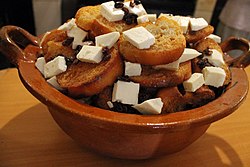 | |
| Type | Bread pudding |
|---|---|
| Place of origin | Spain, Mexico |
| Invented | circa 15th century |
| Serving temperature | Warm or chilled |
| Main ingredients | bolillo, syrup, piloncillo, cinnamon, cheese (if wanted) |
Capirotada (Spanish pronunciation: [kapiɾoˈtaða]) or Capilotade, also known as Capirotada de vigilia, is a traditional Mexican food similar to a bread pudding that is usually eaten during the Lenten period. It is one of the dishes served on Good Friday.
History[edit]
Capirotada originated from an ancient Medieval European dish that was heavily influenced by Roman and, possibly, Moorish cuisine. Capirotada, like bread pudding, was seen as a way to make use of otherwise ruined, stale bread.[1] In —Arte Cisoria— Enrique de Villena (1384–1434) repeatedly mentions capirotadas. Felipe Benicio Navarro y Reig (1840-1901), who studied the works and life of Enrique de Villena, described what Capirotada was:[2]
“CAPIROTADA - This was one of those encyclopedic delicacies that were made for magnificence and in which culinary art applied that reasoned eclecticism that is its essence and should be its purpose. Similar to the Olla podrida in its foundations, it affected more select shapes and constituted a spectacular dish. It was composed of pork, partridges and sausages, or other foods of this nature, all roasted and cut into medium pieces. With slices of bread and with these pieces, alternating beds were formed and sprinkled with grated cheese that was seasoned with pepper, nutmeg and ginger. Formed, then, on the plate, a beautiful pyramid of these various foodstuffs was covered with fried eggs and on top of them a mixed sauce of various compositions, but which was generally made with grated cheese, beaten eggs, a little garlic, broth and a little bit of saffron, so that it would look good after browning the entire delicacy in the oven. These capirotadas were also made only with poultry, and Don Enrique alludes to them where and when he mentions them. In case there is someone who calls this delicacy absurd, embryonic and not very fine, it would be good to remind him that the fricassée of the modern masters is nothing more than a capirotada, despite being so old that even the Archpriest of Hita mentions it as a select delicacy in a chapter of his Cantares, in which he describes the reception given to Amor by clerics, laymen and friars, saying: He often ate chickens in capirotada.”
Legend holds that the dish, formally known as capirotada de vigilia, was created in order to use leftovers before Lent began.[3][4] The word "capirotada" comes from the Spanish word "capirote", which refers to the tall, conical hat in a religious context.[4]
The dish traveled to the New World along with Spanish conquistadores, who spread both the Catholic religion and Spanish culture to the indigenous peoples. In post-conquest Mexico, indigenous peoples like the Aztecs used anise tea to soften stale bread and moisten dry meat, both of which were common problems on Spanish ships making the voyage across the Atlantic.[5] Previously a more savory dish, capirotada progressively became sweeter after New World ingredients and indigenous traditions were combined with the existing Spanish version, leading to a large increase in the varieties of capirotada.[6]
Despite originally being consumed before Lent, capirotada is now consumed during Lent, especially during Holy Week and on Good Friday.[7]
Religious importance[edit]
Recently, it has been given a spiritual meaning in relation to the passion of Christ and the Lenten season, thus, for many people, the bread represents the Body of Christ, the syrup is his blood, the cloves are the nails of the cross, and the whole cinnamon sticks are the wood of the cross.[8] The melted cheese stands for the Holy Shroud.[1]
Ingredients[edit]

Common ingredients[edit]
There are various preparations of the dish. It is generally composed of toasted bolillo (which is like the French baguette) and soaked in a mulled syrup made of the following: whole cane sugar, which is known as piloncillo; clove; and cinnamon sticks. Some of the typical ingredients include nuts, seeds, and dried (and sometimes fresh) fruits, among these are: apples, dates, raisins, apricots, peanuts, pecans, almonds, pine nuts and walnuts. In addition, aged cheese is added, which might explain why some people's recipes call for milk.[3]
Uncommon ingredients[edit]
Many capirotada recipes do not include any meat due to the dish's traditional association with Lent, though some do include meat as a layer.[3] Some versions of capirotada include tomato and onion for the syrup. Other iterations make use of cilantro, bay leaves, banana, or sprinkles.[8]
See also[edit]
Notes[edit]
- ^ a b Mather, Robin (4 April 2017). "Mexican Easter bread pudding with a long culinary lineage". chicagotribune.com. Retrieved 2020-09-04.
- ^ de Villena, Enrique; Navarro, Felipe Benicio (1879). Arte Cisoria. Madrid: Murillo. p. 208. Retrieved 23 November 2023.
- ^ a b c Jose Luis Juarez Lopez La capirotada Mexico desconocido 25 May 2013
- ^ a b "Authentic Mexican Capirotada Recipe". www.experience-san-miguel-de-allende.com. Retrieved 2020-09-04.
- ^ Reyna, Nubia (2020-04-10). "Chef shares history of capirotada during Lent Season". Valley Morning Star. Archived from the original on 2020-09-30. Retrieved 2020-09-04.
- ^ Grodinsky, Peggy; Chronicle, Copyright 2008 Houston (2008-02-05). "Capirotada: the sweet smell of home". Houston Chronicle. Retrieved 2020-09-04.
{{cite web}}: CS1 maint: numeric names: authors list (link) - ^ Capirotada Archived 2019-06-16 at the Wayback Machine The Zenchilada page 102 Winter 2011]
- ^ a b "Eatymology: Capirotada". The Local Palate. 2018-03-26. Archived from the original on 2020-10-28. Retrieved 2020-09-04.
References[edit]
- "Capirotada recipes". The Houston Chronicle. Feb 4, 2008.
External links[edit]
- Texas Mexican Secret Spanish Jews Today Archived 2013-02-12 at the Wayback Machine











